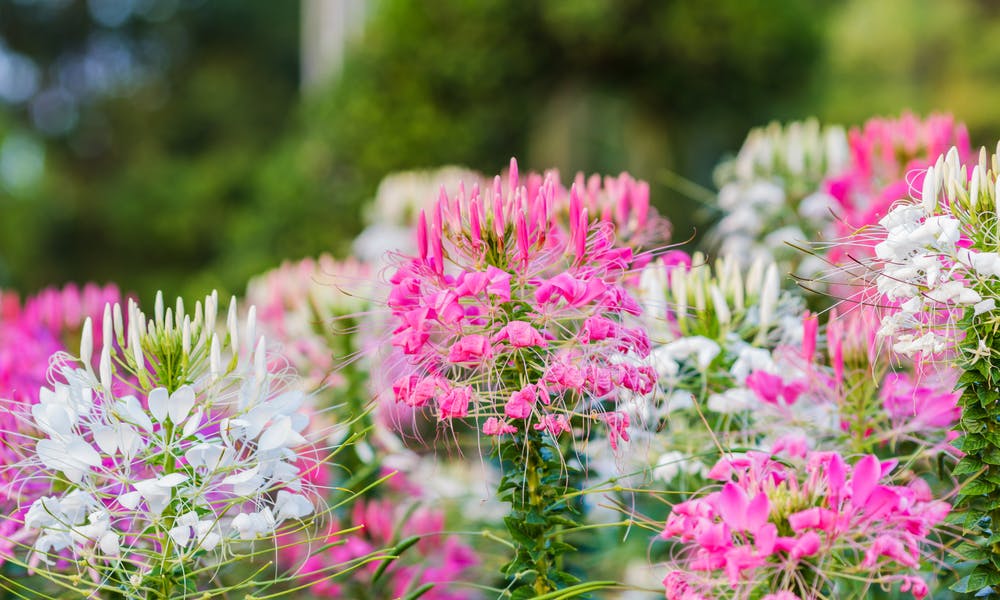MENU
Spider Flowers are Beautiful Flowers with a Scary Name

Flowers are pure and beautiful creations of nature. In some cultures, they are even offered to gods. In our societies, it is common to offer a bouquet to a lover or a special person to express precious feelings because of its beauty and purity. You can find flowers with different sizes, species, colors, and shapes. Flowers like roses, lilies, dahlias, and more are famous for their beauty and glamour.
This article is about the spider flower or Cleome hassleriana. It is a very graceful plant with a very special inflorescence. With its small flowers arranged at the top of the central stem, forming a ball that resembles a spider. The large stamens of long-stalked flowers are prominent and grouped in loose spikes. The spider flower is a beautiful annual plant, native to the tropical regions of South America, but you can find it naturalized in other parts of the world.
In this article, the following points are introduced:
- Description of the spider flower
- What are the main species and varieties?
- How to plant spider flowers?
- How to maintain the spider flowers?
Description of the Spider Flower
The spider flower, or Cleome hassleriana, is a plant native to the sandy plains and valleys of the tropical regions of South America. This plant does not tolerate frost and does not withstand temperatures below 6-8 degrees C. Like its cousin the caper, it belongs to the Caparaceae family. You can find it in different parts of the world.
With rapid growth, the spider flower quickly forms a beautiful tuft, which can exceed 1 m in height and extend up to 45 cm in width. Its fine, deciduous, clear green to dark green foliage disappears in the bad season. On this luxuriant vegetation, you can find an astonishing inflorescence, remarkable by their architecture and their lightness. Grouped in fuzzy terminal bouquets, the flowers surprise with their sophisticated structure. Each flower opens into four fine petals at the heart. At their edges, you can see prominent filaments giving a ruffled and refined look.
What are the Main Species and Varieties?
This species comes in interesting hybrids and cultivars like Color Fountain and those of the Queen group. Most of them bear thorny stems. Senorita Rosalita is the best cultivar. Its flowering period is from July to Sept. It offers a long and refined flowering.
One of the most popular flowers of this genus is the Cleome Violet Queen or Cleome Spinosa. It is a long flower in the sumptuous purple-violet color. Of good size, it brings volume and height to the flowerbeds. As a variety, you can find the white Queen Cleome, a pure white flower, crowned with large purple stamens.
There is also the Cleome Senorita Blanca. With its white flowers with pink reflection in dense and aerial inflorescences, it gives height to your garden. Moreover, you can choose Helen Campbell. This annual plant with large development (1m to 1.50m) grows from June to the cold season.
How to Plant the Spider Flower?
This flower is a lover of the sun. It prefers sunny places and heat. It also appreciates the ground remaining fresh during the months of summer. However, it dies quickly as soon as temperatures drop below 2 degrees C. The spider flower should grow in the sun and remain sheltered from the wind: if you want to avoid unsightly staking, it is better to grant it a place sheltered from strong winds, which could cause the stems to lie down.
You should plant the spider flower in a pot during the spring between April and May, as soon as the first rays of sun begin to warm the earth and the climate is favorable. Transplant and store the young plants in mini-clods, under shelters, at a temperature above 14 degrees C for a few weeks before planting them in the garden as soon as the risk of frost is gone.
How to Maintain the Spider Flower?
The spider flower requires almost no maintenance: just make sure the substrate never dries. Water it very regularly, twice a week. In case of high heat, water it at the base of the plant, not on the foliage. Mulch with a 2 cm layer of dry straw or peat to maintain moisture throughout the summer. Optionally bring liquid fertilizer once per month.
Remove the faded flowers to promote the appearance of new flowers and extend the flowering time. Do not forget to bring gloves when you handle it because its thorns are as discreet as they are sharp! Plant it in number, rather than isolated; it gives height, thickness and a lot of lightness in a harmony of pastel tones. The spider flowers are ideally matched in height with Verbena from Buenos Aires, cosmos, Oriental Poppies, or other tall summer flowers with which they form beautiful contrasts of floral shapes.
Nature is full of beautiful inspiring creations. One of the most astonishing is flowers, those pure visual and olfactory pleasures with a very large diversity. They can express whatever your heart may hide as feelings of love and consideration, accompany you for all occasions, and give an original touch to the garden and to your flowerbeds. The spider flower, with its scary name, is one of the most gracious and sweet-scented flowers. You can match it with other types of flowers such as verbena, oriental poppies, or cosmos, to bring an original touch to your composition and your garden.
The spider flower does not ask for much care to grow; just make sure the substrate never dries, and water it very regularly. It is going to bring beauty and a very light, yet appreciable perfume to your house. This can undeniably charm your beloved ones and visitors.

